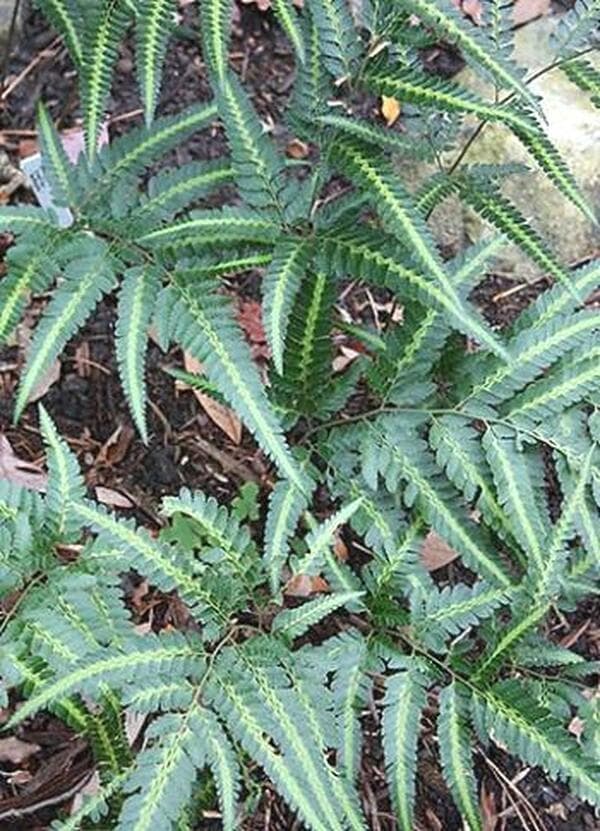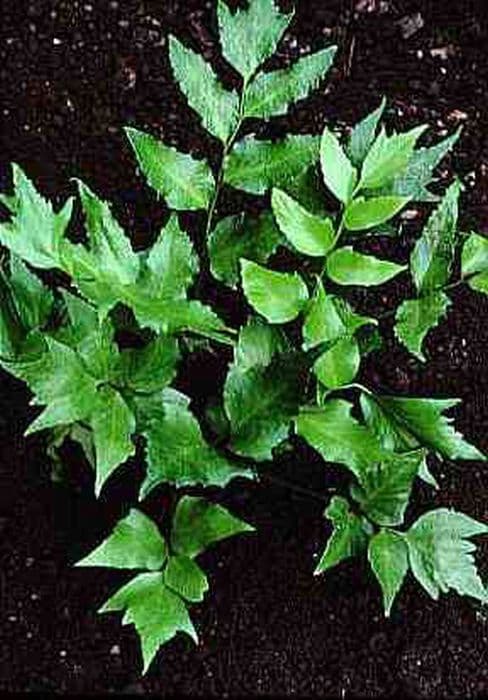Shaggy Shield Fern Dryopteris cycadina

ABOUT
Dryopteris cycadina, commonly known as the shaggy shield fern, is characterized by its robust and arching dark green fronds. The base of each frond is notably covered with large, dark brown or black scales which give a rough, shaggy appearance, hence the name. Its fronds are pinnate, meaning they have leaflets on either side of a central stalk, and these leaflets are also subdivided, giving the fronds a feathery, textured look. As its leaves uncurl from a central rosette, the young, coiled fronds, often referred to as fiddleheads, display a striking crozier shape. The undersides of the older fronds might carry sporangia, which are structures associated with reproduction, and appear as dot-like spores clusters. The overall shape of the plant is somewhat upright but with a tendency to form a vase-like clump. The shaggy shield fern exudes a lush and somewhat wild aesthetic, contributing to its common utilization in shady garden landscapes or woodlands settings where it can convey a natural, untamed beauty.
About this plant
 Names
NamesFamily
Dryopteridaceae
Synonyms
Shaggy Shield Fern, Black Wood Fern
Common names
Dryopteris atrata, Aspidium atratum, Nephrodium atratum, Lastrea atrata, Dryopteris hondoensis.
 Characteristics
CharacteristicsLife cycle
Perennials
Foliage type
Evergreen
Color of leaves
Green
Height
2-3 feet (0.6-0.9 meters)
Spread
2-3 feet (0.6-0.9 meters)
Plant type
Fern
Hardiness zones
8
Native area
Asia
Benefits
 General Benefits
General Benefits- Aesthetic Appeal: Dryopteris cycadina, commonly known as Shaggy Shield Fern, adds a lush, green look to gardens with its wide, arching fronds.
- Erosion Control: The dense growth habit and expansive root system help stabilize soil and control erosion on slopes.
- Habitat for Wildlife: This fern can provide shelter and humidity for various forms of wildlife, including insects and small animals.
- Low Maintenance: Shaggy Shield Fern requires little care once established, making it an excellent choice for gardeners seeking minimal upkeep.
- Drought Tolerance: Although they prefer moist environments, they can withstand periods of dryness once mature, making them fairly resilient in changing conditions.
- Shade Tolerant: Perfect for shaded or semi-shaded areas of a garden where few other plants thrive.
- Companion Planting: Works well alongside other shade-loving plants to create a varied texture and depth in garden design.
- Decorative Year-Round: Despite being deciduous, the distinctive foliage provides visual interest throughout growing seasons, with colors that sometimes change in autumn.
 Medical Properties
Medical PropertiesThis plant is not used for medical purposes.
 Air-purifying Qualities
Air-purifying QualitiesThis plant is not specifically known for air purifying qualities.
 Other Uses
Other Uses- Shady Garden Accent: Shaggy Shield Fern, with its attractive foliage, can add visual interest and texture under larger trees and in shady garden corners.
- Erosion Control: Its ability to grow in dense clumps makes it an effective plant for stabilizing soil on slopes and in areas prone to erosion.
- Fernery Collections: As a unique species, Shaggy Shield Fern is sought after by fern enthusiasts to include in collections due to its distinct frond structure.
- Backdrop Planting: Its height and fullness can provide an excellent green backdrop for flowering plants in a mixed border.
- Wildlife Habitat: Shaggy Shield Fern can create microhabitats for small invertebrates and contribute to the biodiversity of a garden.
- Historical Gardening: It can be used in gardens aiming to recreate the look and feel of Victorian-era ferneries, which were once popular.
- Vivariums and Terrariums: Shaggy Shield Fern can be grown in enclosed environments for humidity-loving reptiles and amphibians, adding a naturalistic touch to their habitats.
- Arts and Crafts: Fronds of the fern may be pressed and preserved to be used in botanical art or herbarium collections.
- Garden Themes: Featuring in Japanese garden designs, Shaggy Shield Fern fits well with the aesthetic of tranquility and greenery that such gardens uphold.
- Theatrical Scenery: The fronds can be used in stage design and set decoration to evoke a forested or woodland scene.
Interesting Facts
 Feng Shui
Feng ShuiThe Shaggy Shield Fern is not used in Feng Shui practice.
 Zodiac Sign Compitability
Zodiac Sign CompitabilityThe Shaggy Shield Fern is not used in astrology practice.
 Plant Symbolism
Plant Symbolism- Perseverance and Endurance: As a fern, Dryopteris cycadina, commonly known as Shaggy Shield Fern, can thrive in challenging conditions, representing an individual's ability to persist and endure hardship.
- Protection: Ferns like the Shaggy Shield Fern have been traditionally associated with protection and safety; their lush foliage symbolizes a shelter or refuge against negative forces.
- Secret Bond: In the language of plants, ferns often symbolize secretiveness or a hidden bond, reflecting the plant's preference for shaded, private areas in the wild.
- Rebirth and New Beginnings: The emergence of new fronds from the soil is symbolic of new beginnings or starting afresh, as the fern cycles through the seasons.
- Solitude: The Shaggy Shield Fern’s preference for growing in quiet, undisturbed places can be symbolic of a person's need for solitude or a period of personal growth in isolation.
 Water
WaterThe Shaggy Shield Fern should be watered deeply but infrequently, allowing the soil to dry out slightly between waterings. This typically means watering the plant once a week with about 16 ounces of water, but this can vary depending on factors such as temperature and humidity which affect the soil moisture levels. During the winter dormant period, reduce watering further to prevent waterlogging, which could cause root rot. It's also best to water the plant at soil level to avoid wetting the fronds, which could lead to fungal diseases.
 Light
LightThe Shaggy Shield Fern thrives best in partial to full shade conditions. It should be placed in a spot where it receives indirect light or dappled sunlight, as direct sunlight can scorch the fronds. An ideal spot for this fern would be a north-facing window or a shaded area in the garden that mimics its natural understory habitat.
 Temperature
TemperatureThe Shaggy Shield Fern prefers cooler temperatures, ideally between 60 to 75 degrees Fahrenheit. It can tolerate a range down to 50 degrees Fahrenheit and up to 85 degrees Fahrenheit, but prolonged exposure outside of its ideal temperature range can stress the plant. Make sure it is protected from frost, which can damage the fronds.
 Pruning
PruningPruning the Shaggy Shield Fern is mainly done to remove any dead or damaged fronds, which helps to encourage healthy growth and maintain the plant's appearance. Pruning should be done as needed, typically in the spring before new growth begins. It's best to prune back to the base of the plant, being careful not to damage new emerging fronds.
 Cleaning
CleaningAs needed
 Soil
SoilShaggy shield fern thrives best in a well-draining soil mix, rich in organic matter, with a pH ranging from 5.5 to 6.5. A mixture of two parts peat, one part loam, and one part sand or perlite is ideal to ensure proper aeration and moisture retention.
 Repotting
RepottingShaggy shield ferns generally prefer to be repotted every two to three years to refresh the soil and accommodate root growth. Repot in spring before the new fronds emerge for best results.
 Humidity & Misting
Humidity & MistingThe shaggy shield fern flourishes in high humidity environments, ideally between 60% to 70%. To maintain these levels, especially in dry indoor air, regular misting or a humidifier can be beneficial.
 Suitable locations
Suitable locationsIndoor
Place shaggy shield fern in indirect light, maintain humidity, and water regularly.
Outdoor
Plant shaggy shield fern in shady area with moist soil and shield from wind.
Hardiness zone
5-8 USDA
 Life cycle
Life cycleThe Shaggy Shield Fern, Dryopteris cycadina, begins its life cycle as a spore released from the undersides of mature fern fronds. These spores germinate in moist, shaded conditions to produce a tiny heart-shaped gametophyte, known as a prothallus. The prothallus houses both male and female reproductive organs, enabling it to produce sperms and eggs; when water is present, sperm swim to an egg to accomplish fertilization, resulting in a zygote. This zygote then develops into a new sporophyte, which is the familiar leafy fern plant. The sporophyte matures by producing fronds that uncoil from a central rhizome—a process known as circinate vernation. As the plant ages, the fronds mature and develop sori, clusters of sporangia on their undersides, which eventually release spores to continue the cycle.
 Propogation
PropogationPropogation time
Spring-early summer
The Shaggy Shield Fern, commonly known as Dryopteris cycadina, is typically propagated by division, a method frequently employed in late winter to early spring before the onset of new growth. The process involves carefully digging up the mother plant, ensuring a substantial amount of root and crown are attached to each divided section. Sections should be replanted in moist, well-draining soil, and situated in a shaded or semi-shaded location to mimic their natural growing conditions. It is important to maintain even moisture after planting to facilitate successful establishment. This method of vegetative propagation maintains the characteristics of the parent plant and allows for rapid increase in the number of plants.









